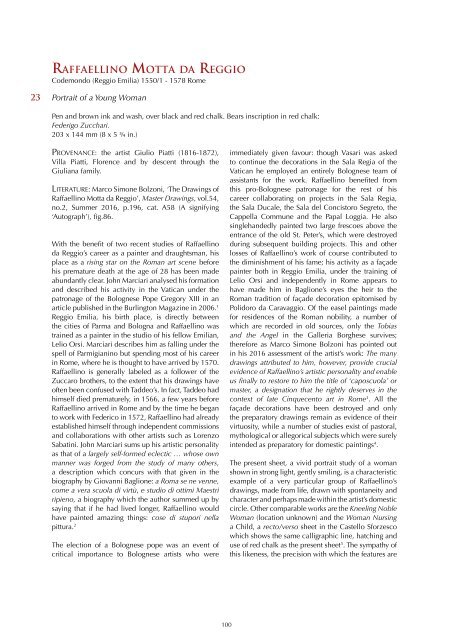You also want an ePaper? Increase the reach of your titles
YUMPU automatically turns print PDFs into web optimized ePapers that Google loves.
Raffaellino Motta da Reggio<br />
Codemondo (Reggio Emilia) 1550/1 - 1578 Rome<br />
23<br />
Portrait of a Young Woman<br />
Pen and brown ink and wash, over black and red chalk. Bears inscription in red chalk:<br />
Federigo Zucchari.<br />
203 x 144 mm (8 x 5 ¾ in.)<br />
Provenance: the artist Giulio Piatti (1816-1872),<br />
Villa Piatti, Florence and by descent through the<br />
Giuliana family.<br />
Literature: Marco Simone Bolzoni, ‘The <strong>Drawings</strong> of<br />
Raffaellino Motta da Reggio’, Master <strong>Drawings</strong>, vol.54,<br />
no.2, Summer <strong>2016</strong>, p.196, cat. A58 (A signifying<br />
‘Autograph’), fig.86.<br />
With the benefit of two recent studies of Raffaellino<br />
da Reggio’s career as a painter and draughtsman, his<br />
place as a rising star on the Roman art scene before<br />
his premature death at the age of 28 has been made<br />
abundantly clear. John Marciari analysed his formation<br />
and described his activity in the Vatican under the<br />
patronage of the Bolognese Pope Gregory XIII in an<br />
article published in the Burlington Magazine in 2006. 1<br />
Reggio Emilia, his birth place, is directly between<br />
the cities of Parma and Bologna and Raffaellino was<br />
trained as a painter in the studio of his fellow Emilian,<br />
Lelio Orsi. Marciari describes him as falling under the<br />
spell of Parmigianino but spending most of his career<br />
in Rome, where he is thought to have arrived by 1570.<br />
Raffaellino is generally labeled as a follower of the<br />
Zuccaro brothers, to the extent that his drawings have<br />
often been confused with Taddeo’s. In fact, Taddeo had<br />
himself died prematurely, in 1566, a few years before<br />
Raffaellino arrived in Rome and by the time he began<br />
to work with Federico in 1572, Raffaellino had already<br />
established himself through independent commissions<br />
and collaborations with other artists such as Lorenzo<br />
Sabatini. John Marciari sums up his artistic personality<br />
as that of a largely self-formed eclectic … whose own<br />
manner was forged from the study of many others,<br />
a description which concurs with that given in the<br />
biography by Giovanni Baglione: a Roma se ne venne,<br />
come a vera scuola di virtù, e studio di ottimi Maestri<br />
ripieno, a biography which the author summed up by<br />
saying that if he had lived longer, Raffaellino would<br />
have painted amazing things: cose di stupori nella<br />
pittura. 2<br />
The election of a Bolognese pope was an event of<br />
critical importance to Bolognese artists who were<br />
immediately given favour: though Vasari was asked<br />
to continue the decorations in the Sala Regia of the<br />
Vatican he employed an entirely Bolognese team of<br />
assistants for the work. Raffaellino benefited from<br />
this pro-Bolognese patronage for the rest of his<br />
career collaborating on projects in the Sala Regia,<br />
the Sala Ducale, the Sala del Concistoro Segreto, the<br />
Cappella Commune and the Papal Loggia. He also<br />
singlehandedly painted two large frescoes above the<br />
entrance of the old St. Peter’s, which were destroyed<br />
during subsequent building projects. This and other<br />
losses of Raffaellino’s work of course contributed to<br />
the diminishment of his fame; his activity as a façade<br />
painter both in Reggio Emilia, under the training of<br />
Lelio Orsi and independently in Rome appears to<br />
have made him in Baglione’s eyes the heir to the<br />
Roman tradition of façade decoration epitomised by<br />
Polidoro da Caravaggio. Of the easel paintings made<br />
for residences of the Roman nobility, a number of<br />
which are recorded in old sources, only the Tobias<br />
and the Angel in the Galleria Borghese survives;<br />
therefore as Marco Simone Bolzoni has pointed out<br />
in his <strong>2016</strong> assessment of the artist’s work: The many<br />
drawings attributed to him, however, provide crucial<br />
evidence of Raffaellino’s artistic personality and enable<br />
us finally to restore to him the title of ‘caposcuola’ or<br />
master, a designation that he rightly deserves in the<br />
context of late Cinquecento art in Rome 3 . All the<br />
façade decorations have been destroyed and only<br />
the preparatory drawings remain as evidence of their<br />
virtuosity, while a number of studies exist of pastoral,<br />
mythological or allegorical subjects which were surely<br />
intended as preparatory for domestic paintings 4 .<br />
The present sheet, a vivid portrait study of a woman<br />
shown in strong light, gently smiling, is a characteristic<br />
example of a very particular group of Raffaellino’s<br />
drawings, made from life, drawn with spontaneity and<br />
character and perhaps made within the artist’s domestic<br />
circle. Other comparable works are the Kneeling Noble<br />
Woman (location unknown) and the Woman Nursing<br />
a Child, a recto/verso sheet in the Castello Sforzesco<br />
which shows the same calligraphic line, hatching and<br />
use of red chalk as the present sheet 5 . The sympathy of<br />
this likeness, the precision with which the features are<br />
100
















